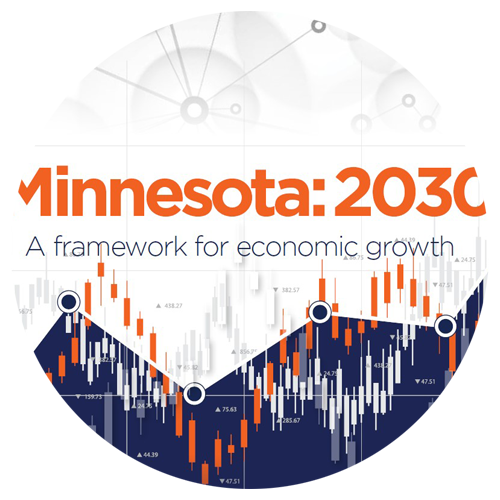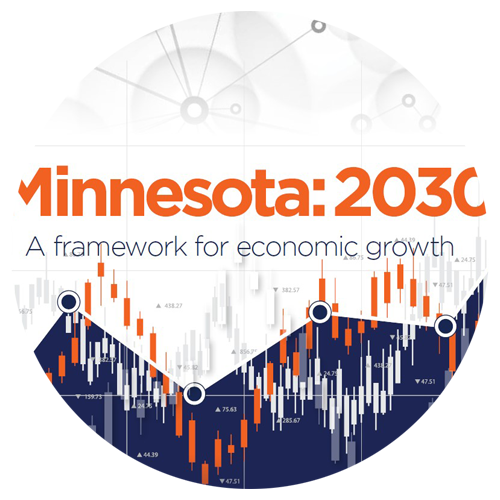Framework and strategies for growth
Minnesota: 2030
A framework for economic growth
Not all future changes in technologies, markets and individual business decisions can be predicted with precision or built into standard forecasting models. Events like the COVID-19 pandemic are a case in point.
Some trends can be forecasted with a fair degree of confidence, however, giving everyone a better sense of how the economy is likely to change in coming years enabling thoughtful actions to steward the future benefitting all Minnesotans. For example, here are some safe bets about the next decade:
- Minnesota’s population will continue to age and the labor force will continue to grow only slowly, exacerbating already significant workforce challenges. The availability of talent will only increase as a key driver of economic competitiveness.
- Health care and technology advancements will play increasingly large roles in the economy. New technologies will continue to transform industries and shift the skillsets demanded in the workforce. Likewise, global demand for health and wellness
goods and services will increase in the face of aging populations in developed countries and raising living standards in emerging markets. - Resilient economies able to adapt to change will be better equipped to absorb the shocks of unexpected events and shifting market forces.
- A growing economy will require strong communities with the underlying assets needed to serve residents and help businesses expand.
- Minnesota’s population will be more diverse, with communities of color making up a larger share of the workforce, consumer base and business community.
Global megatrends, such as water and resource constraints, climate change and rising global food demand, will also influence Minnesota’s economy and shape opportunities in the coming decade.
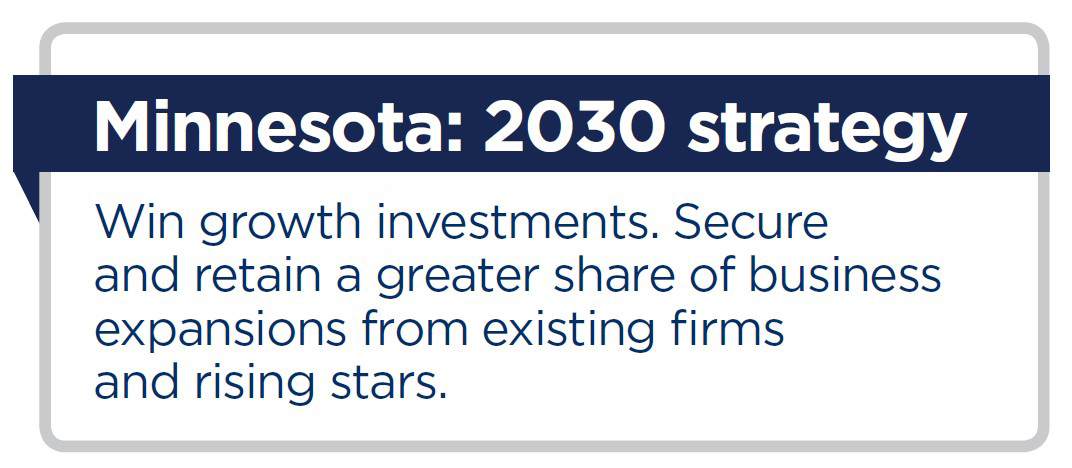
The objective of Minnesota: 2030 is to establish a strategic framework that acknowledges and prepares for such changes, helping Minnesota develop and grow to its full potential. This report lays out three fundamental strategies: Build on strengths, leverage Minnesotans and strengthen communities.
Each strategy is outlined in the Minnesota: 2030 report, with specific priorities and recommendations for ensuring an even brighter economic future for Minnesota and Minnesotans.
Build on strengths acknowledges Minnesota’s diverse strengths across a range of industries, including corporate headquarters, food and agriculture, manufacturing, health care and med-tech, to name a few. Continuing to diversify the economy while investing in high-growth areas like health care and technology will allow Minnesota to accelerate economic activity while remaining resilient.
Leverage Minnesotans addresses the foundational imperative to grow the workforce and help individuals develop the skills they need to succeed in a 21st century economy. This will require Minnesota to retain and attract talent, to increase workforce participation by ensuring no one is left on the economic sidelines, and to rethink how public- and private-sector stakeholders work together to respond to evolving skill and training needs.
Strengthen communities lays out two critical priorities. The first is to deliver necessary housing, child care and digital connectivity. These are foundational elements of community vitality and growth, and each area faces supply side challenges that must be addressed. The second priority is to embrace all Minnesotans and make workforce inclusion a strength. Minnesota is strengthened by its diverse populations, but unacceptable disparities pose both a moral and economic imperative. Minnesota has immense advantages – not least its private sector businesses – that can turn diversity into a strength making Minnesota a leader in innovative practices that help boost the economy by helping all Minnesotans flourish.
These three Minnesota: 2030 strategies rose repeatedly to the surface as this report assessed strengths, analyzed Minnesota’s economic performance, and conferred with key stakeholders. Within each, recommendations and action plans are proposed.
Minnesota: 2030 is a framework for discussing and embracing what Minnesotans can do together to sustain and grow our economy to its fullest potential this decade.
Strategy One: Build on strengths
Minnesota has a diverse and resilient economy with industry strengths and natural resource advantages.
Measured by distribution of employment across industries, Minnesota has the 5th most diverse state economy, and the economy has only become increasingly diverse over time. The resiliency of the state’s diverse economy aided Minnesota in the recessions of 2007 and 2020 when unemployment rose less severely in Minnesota than in the U.S. Minnesota businesses also exhibit high levels of adaptability and longevity, with the 4th highest five-year business survival rate in the nation in 2019.
Minnesota has high sector concentrations in manufacturing, food and agriculture, management of companies, finance and insurance, and health care. It has strong regional clusters in industries such as metal ore mining, forestry products, tourism, recreation and specialized manufacturing. Some strengths are accidents of history, others leverage state endowments or natural resources not easily replicated. Synergies and compatibilities could also be leveraged for future development.
Take the state’s food and agriculture sector. Like its Midwestern neighbors, Minnesota is a major food producer. In fact, Minnesota was the 5th largest agricultural producer in the U.S. in 2019, trailing only California, Iowa, Nebraska and Texas. What sets Minnesota apart, however, is that it is also home to leading global food and agricultural headquarters companies driving food innovation and management, as well as specialized manufacturing and service industries producing new technologies and critical inputs for the food and ag sector. This is explored more deeply in the food and agriculture strategy section – and Minnesota clearly has considerable opportunity to continue to leverage these food and ag innovation strengths across the value chain this decade.
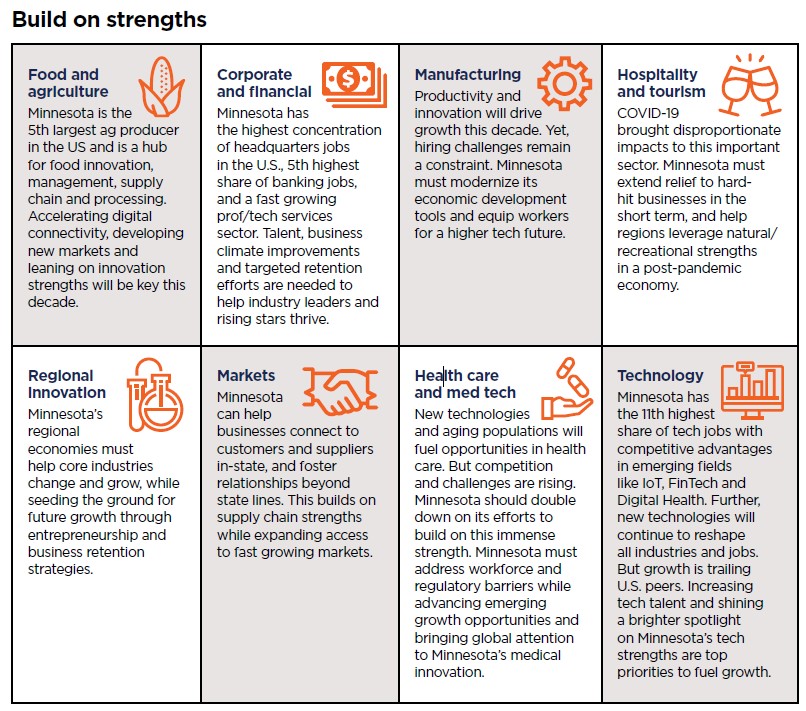
Building on Minnesota’s strengths includes:
- Protecting and stewarding Minnesota’s strengths as a priority. Minnesota should carefully steward its valuable economic assets and industries. Proactive retention strategies that address key needs and facilitate expansion and growth should be a priority.
- Helping industries adapt and capture new opportunities. The paradigmatic success story is the taconite industry, born out of University of Minnesota research in the 1940s and 1950s. Minnesota can leverage strengths with research institutions and tech transfer. The University of Minnesota, for instance, helped launch more than 165 new companies since 2006. These strengths can be built upon to develop, accelerate and grow new industries and opportunities.
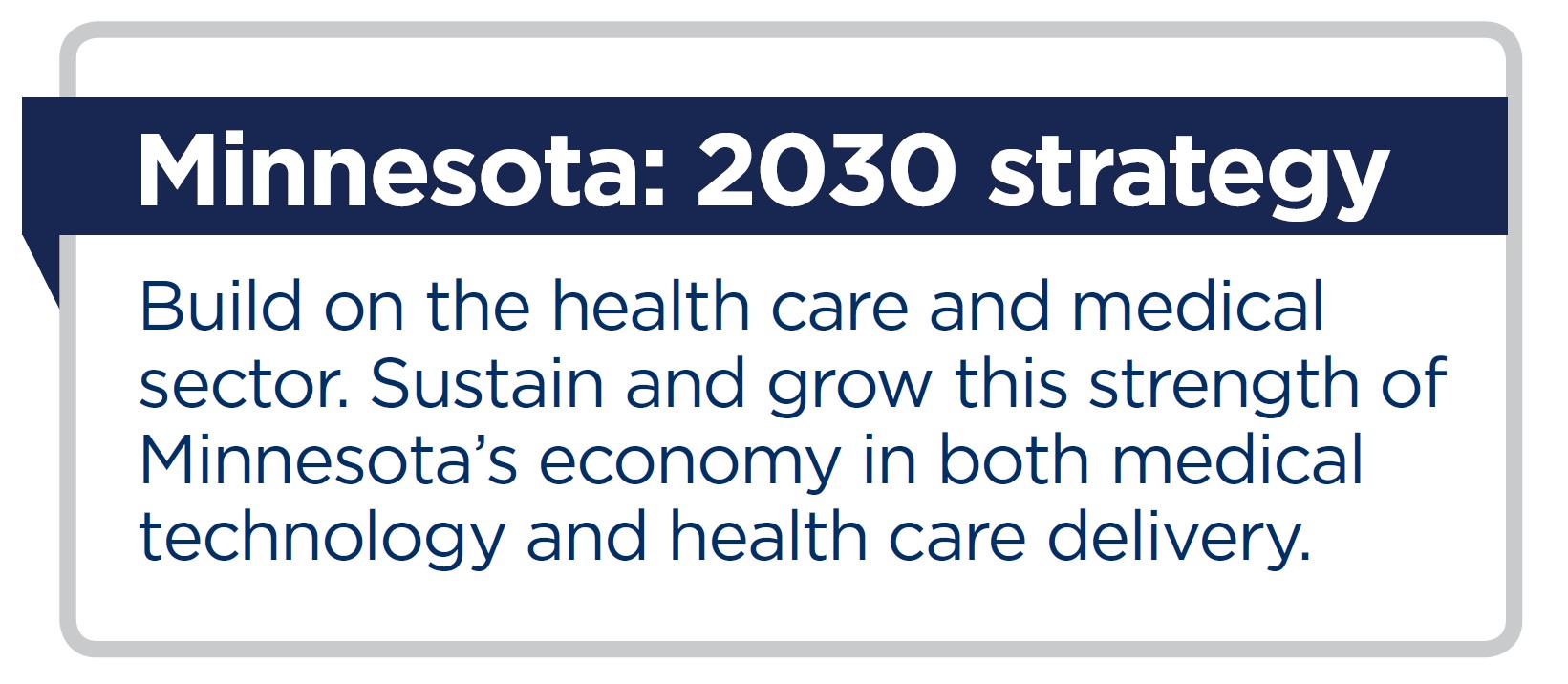
Growth Accelerator: Build on Minnesota’s health care and medical cluster
Minnesota is a global leader in health care. The state is home to health care giants such as Mayo Clinic, UnitedHealth Group and Medtronic, and boasts a diverse range of strengths, from medical devices to health care delivery and insurance. Additionally, emerging growth in biotechnology, pharmaceuticals and digital health points to a potentially new phase in Minnesota’s evolving health care landscape.
As the full report explores, the 2030 opportunity is to build on this strength to accelerate growth through innovation, retention and expansion strategies, start-up support and smart investments in infrastructure, policy change and talent initiatives. Doing so would strengthen Minnesota as a global leader in health care innovation and further ensure Minnesotans have access to high-quality health care services for years to come.
A suggestion 30 years ago that the state work to create the health and medical cluster Minnesota enjoys today would have been dismissed as outlandish. Yet look at the successes it illustrates today.
The future opportunity is even more significant. Health care will leap forward this decade. Technology advancements, consumer-driven care, digital health, coverage innovation, device innovation, remote care and telehealth are exciting new opportunities. Demographic change, rising costs and financial pressure will raise temperatures the other direction. This will challenge the stability of the state’s health care delivery sector, particularly in rural communities.
Yet Minnesota’s strengths in this sector position it exceptionally well to capitalize on opportunities and address future challenges, not least because of Minnesota’s enviable array of leaders in care delivery, insurance, consumer insights, data analytics, medical devices, pharmaceuticals and other new health technologies.
Success is not guaranteed. Minnesota’s health and medical cluster faces challenges and competition from internet companies, retail giants and new entrants from Silicon Valley to Israel to China. Innovation and competition could threaten Minnesota’s medical cluster – or embolden it.
Stakeholders in Minnesota’s business community and public sector should consider strategies to support, strengthen and grow this critical aspect of the state’s economy. Minnesota’s health care and medical cluster is a unique asset playing an outsized role in the economy. It will play an even bigger role in shaping Minnesota’s economic future to 2030 and beyond.
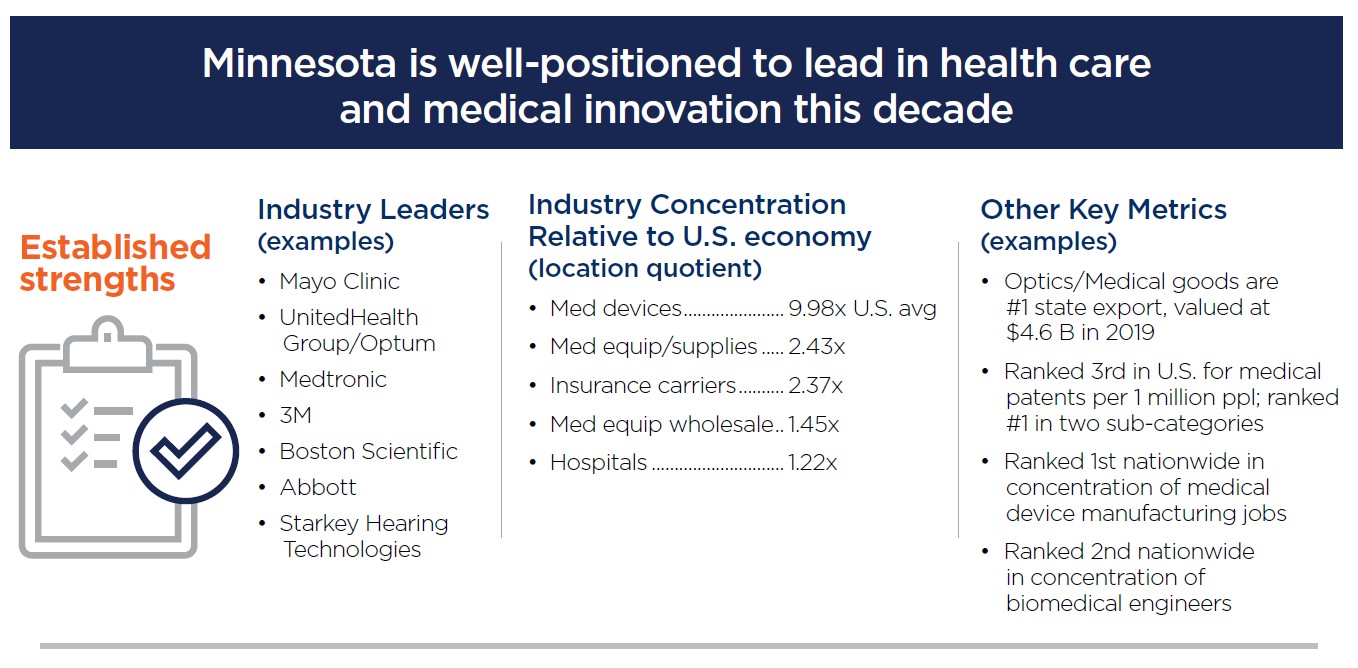

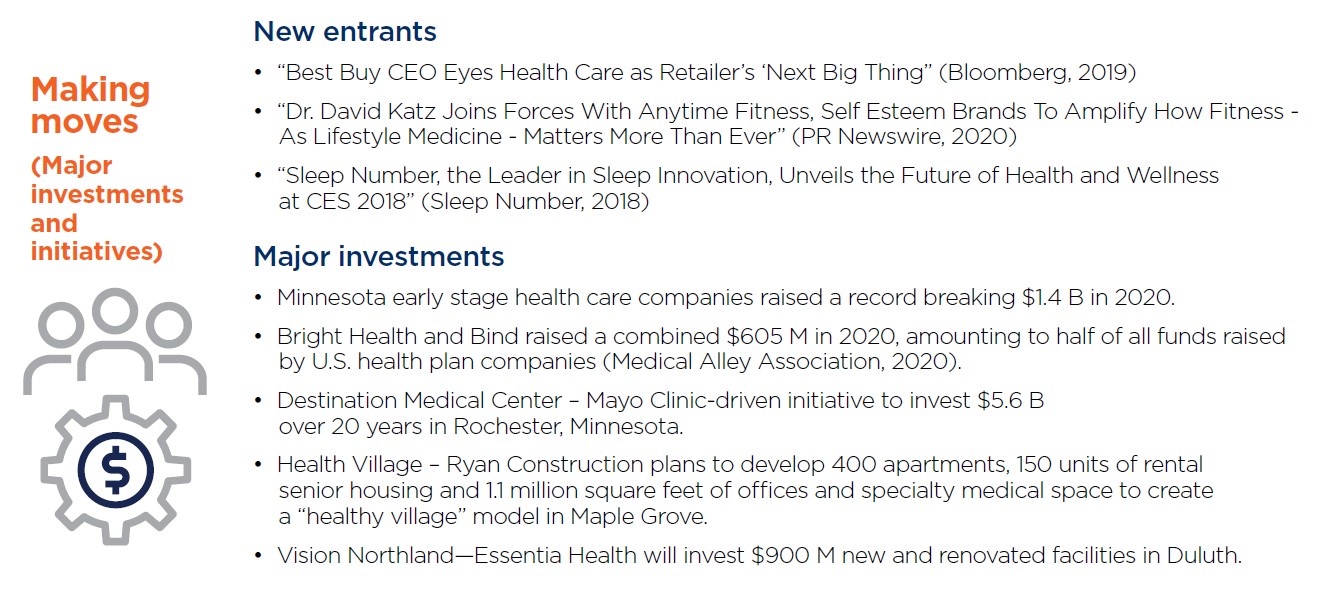
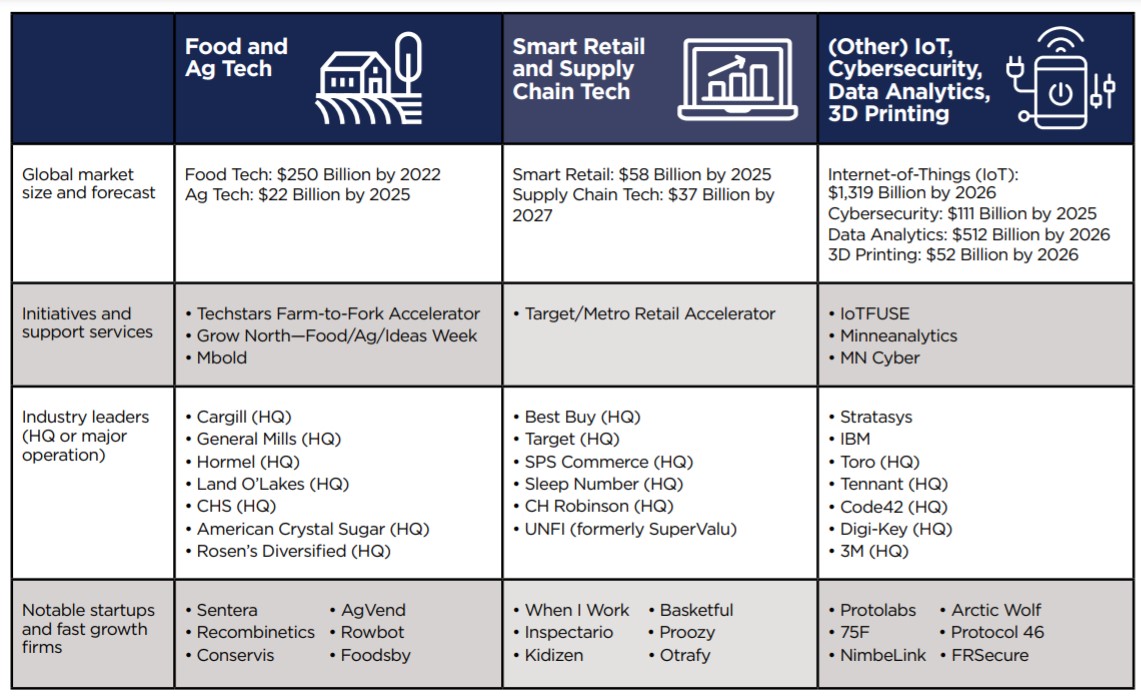
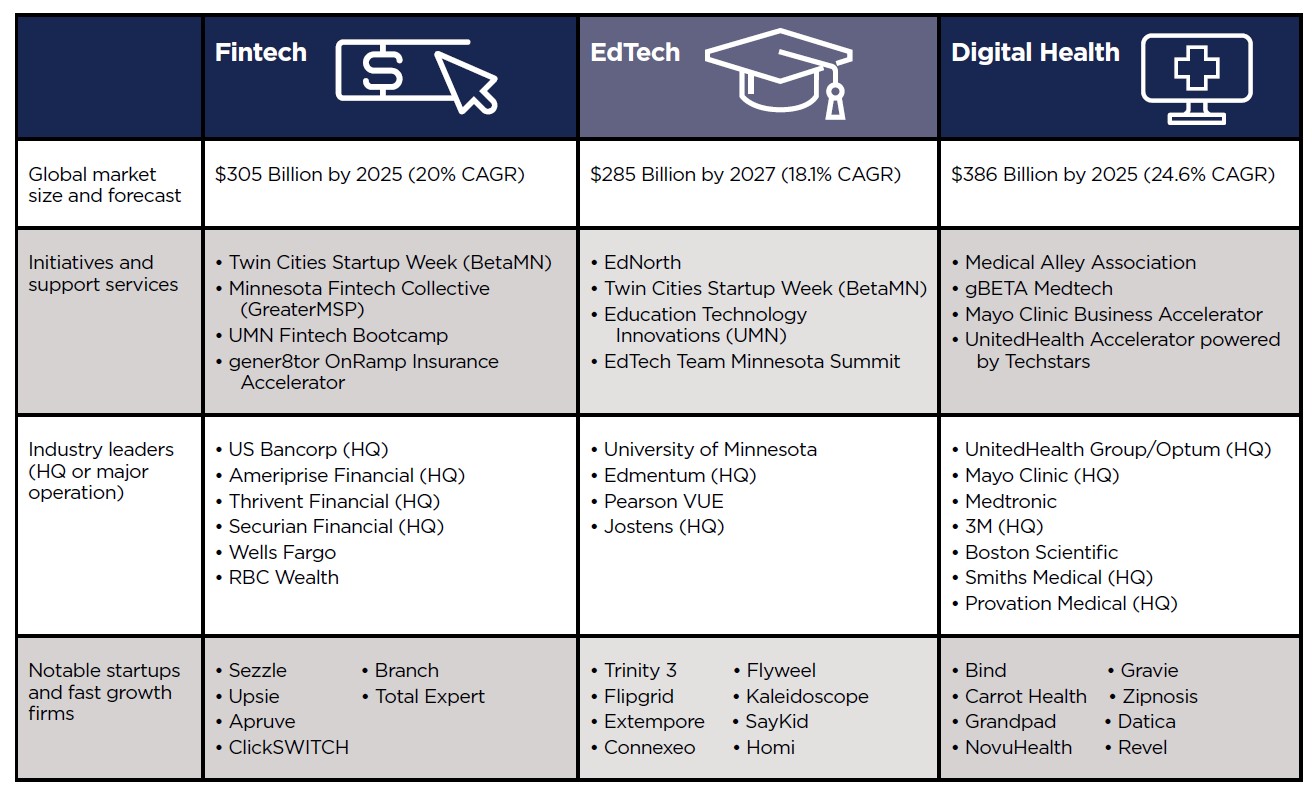
Growth Accelerator: Compete and succeed in the future technology economy
Technology is changing the global economy – and the pace is only accelerating.
Minnesota was an early leader in tech but has trailed peer states and the U.S. in recent years. Indeed, sluggish growth in tech and tech occupations has been a major factor in Minnesota’s economic underperformance for almost a decade. Forecasts project an underwhelming future if Minnesota doesn’t change.
So why does Minnesota: 2030 advance “compete and succeed” in the future tech economy as a growth accelerator?
Because new technologies are transforming a wider set of industries and redefining what it means to be a “tech business.” In this landscape, Minnesota has strengths that position it for growth.
First, Minnesota has a high share of jobs in technology industries and occupations, with the 11th highest concentration of net tech employment (all jobs in tech industries and tech jobs in any industry). Minnesota also has above average tech talent concentrations, with 13 percent more IT professionals, 15 percent more STEM occupations and 14 percent more business services occupations than the U.S. average. Thus, Minnesota has bench strength in advanced industries and the tech talent needed to excel in tech this decade.
Second, Minnesota remains a leader in advanced fields, including health care and medical technology, financial services, corporate headquarters and machinery manufacturing, to name a few. Firms across these industries will be on the forefront of technology changes this decade, whether through digital transformation, data analytics, artificial intelligence, machine learning, Internet of Things (IoT), 3D printing, cybersecurity, block chain or automation.
Achieving full potential will require strengthening Minnesota’s underlying capacity for high-tech growth. This means increasing the availability of tech talent, including core technical workers, such as software and web developers, data scientists, engineers, and tech-equipped talent in diverse fields like nursing, manufacturing, transportation, financial services and more.
It will also require a more developed tech infrastructure to access and enable technologies across the state, as well as an alignment of economic development strategies to shine a brighter spotlight on its high-tech economy. Minnesota’s tech sector remains largely a hidden secret. The state needs to raise its profile to attract talent and ensure Minnesota is a place innovators want to be. Minnesota should put more weight behind efforts to accelerate the growth of the tech economy throughout this decade.
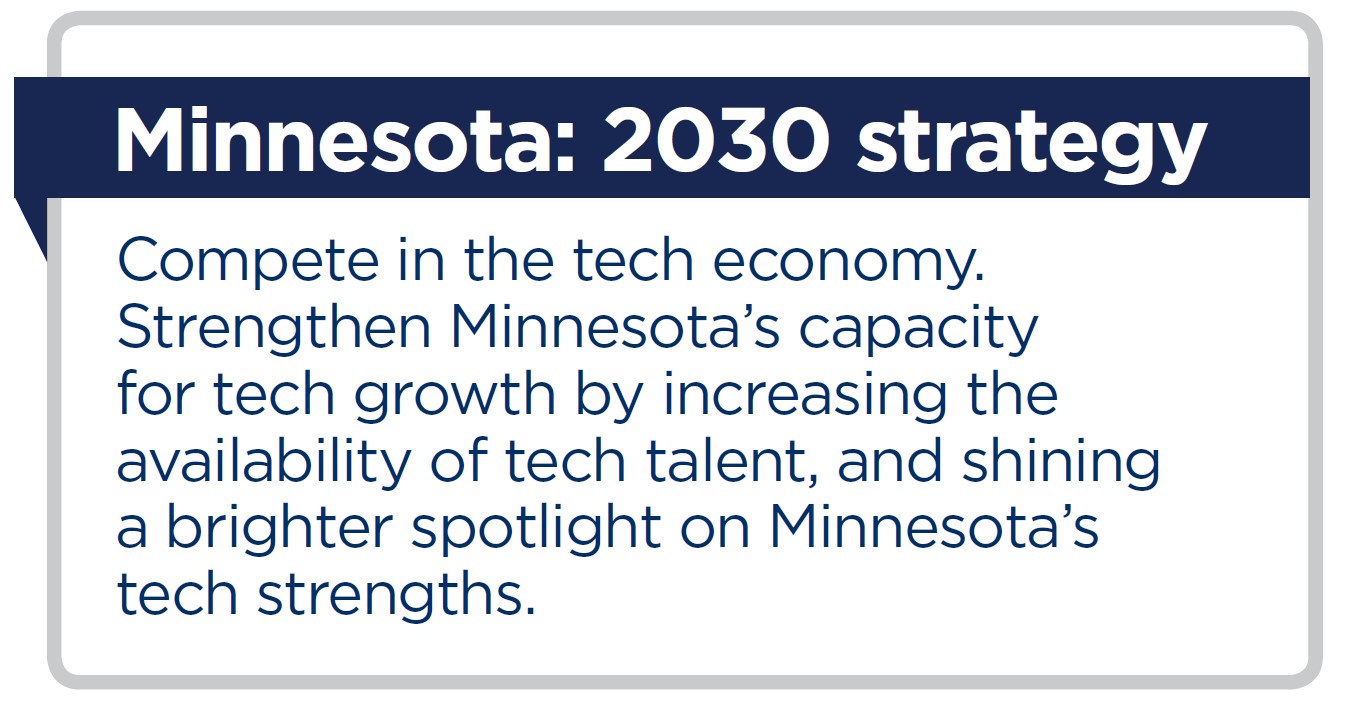
Strategy two: Leverage Minnesotans
Slowing population and labor force growth has been a constraint on Minnesota’s economy for two decades, and both are projected to slow even further. The state demographer projects labor force growth of <0.1 percent a year from 2020-2025. That is simply not enough to fuel growth in the state’s economy. While aging demographics are driving much of this trend, low net migration is also a factor. Minnesota saw net gains in the 1990s, drawing domestic in-migration from other Midwest states to grow its population and workforce. After 2000, however, in-migration from neighboring states slowed, while losses to coastal hubs and the sunbelt accelerated. If not for international migration, Minnesota would have lost more people than it attracted this century. By February 2021, unemployment in Minnesota had again fallen to 4.3 percent, with state Job Vacancy Surveys showing many jobs were going unfilled. Competition for talent is likely to continue being a top challenge for Minnesota this decade. How can Minnesota address this foundational issue, ensuring the state has a growing and vibrant workforce for years to come?
First, Minnesota must beat labor force projections.
Minnesota’s underwhelming economic forecast next decade is heavily influenced by its slow population and slow labor force growth projections. No matter how you cut it, Minnesota needs workforce growth if it wants to grow. Aging demographics and falling birth rates are outside our control, but there are strategies that can help Minnesota increase its number of workers, improving its economic growth potential, specifically:
- Retaining existing talent base (e.g. Decrease the loss of younger Minnesotans, in particular, to other states),
- Improving talent attraction from other states,
- Embracing and increasing international immigration; and,
- Ensuring no one is left on the economic sidelines.
As the Minnesota: 2030 report lays out, Minnesota can improve its economic outlook by retaining and attracting talent, and by bringing people into the workforce who may otherwise be on the sidelines. The state will not only grow our labor force, but also create stronger local communities and deliver greater equity for populations that have faced disadvantages.
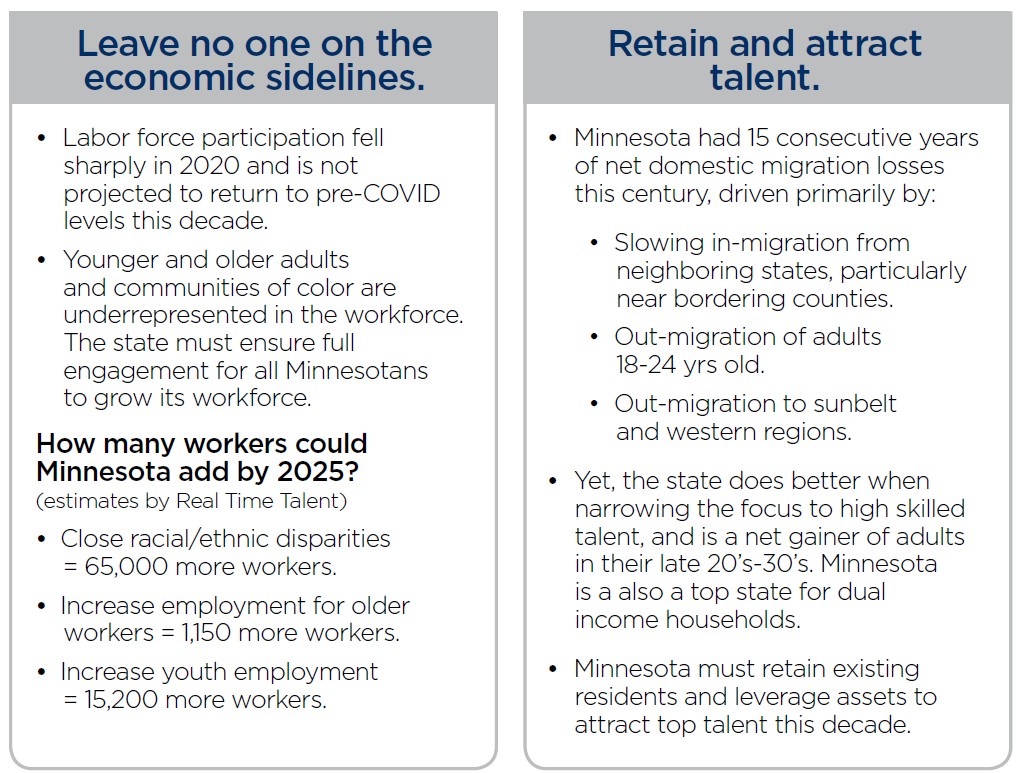
Second, Minnesotans must have the skills to succeed.
Minnesota must rethink how it helps adults develop new skills. The days of performing the same job the same way for much of one’s career are over. Jobs and professions change and evolve quickly.
Minnesota should lead the way in rethinking how public and private sectors work together to provide tools and teach the skills necessary for workers to continually learn and thrive in a changing economy. Lifelong learning and development will be an ongoing career objective for many – and higher ed institutions must adapt and grow to respond to these changes. Not every job requires an advanced degree. Many skilled trades are and will continue to be in high demand. However, the skills deficit facing those who don’t finish high school is only increasing, raising the stakes on successfully seeing students graduate.
This means the state’s ability to provide high quality K-12 education to all Minnesota children, as well as quality higher educational and skills development opportunities for Minnesota adults will be absolutely imperative.
To continue to have a highly-skilled workforce as its economic cornerstone, Minnesota must ensure all students graduate high school prepared for the next phase of life, whether that be postsecondary education or a career. Minnesota students perform well on college entrance ACT scores, and rank 4th in the country in achieving two-year degrees or higher. However, the state’s high school graduation rate is below the national average – ranking 34th – and Minnesota has some of the largest achievement gaps by race, ethnicity and socioeconomic status in the nation. This must be addressed.
Minnesota employers remain committed to engaging educational institutions and students in understanding, teaching and acquiring the skills needed to succeed in the high-demand jobs of tomorrow. Minnesota’s future in many ways depends on how this priority is executed.
Strategy three: Strengthen communities
It is no longer enough for regions to have diverse employment opportunities and high-quality education. Strong community assets and a welcoming culture that embraces all Minnesotans will define the strength of growing communities and provide a competitive advantage economically.
A great career opportunity without reliable and affordable childcare or an affordable place to live is not a formula for economic growth. Communities that lack high-speed connectivity face a competitive disadvantage in attracting both business investment and residents. Their children may also suffer from fewer educational advantages as demonstrated during the COVID-19 pandemic.
To thrive, these issues must be addressed and diversity must be welcomed and embraced. Communities and neighborhoods must develop inclusive cultures and strategies to continue to attract and advance opportunities for populations of color including immigrants and refugees. It is essential to the fabric of our culture and communities – and to the state’s future economic growth.
Strengthen community assets – Child care
Minnesota’s child care conundrum is intensifying. Parents need safe, reliable care for children if one or both parents work. Children, who will become our future workforce, need quality early-learning opportunities, pre-K.
Child care is difficult to find and expensive if you can find it. It was already impacting workplaces and COVID-19 only compounded it. In a Minnesota Chamber poll, 62 percent of member businesses rank affordable child care as a barrier to finding workers – and data points to child care shortages as already impeding economic growth in many Minnesota communities.
Traditional child care models may not be broken entirely everywhere, but often only Band-Aids hold certain aspects together. Analysis is required to address the ability of private-sector supply in response to market demand, as well as the intersection of public program and child care funding.
Supply and demand solutions both seem necessary. Solutions could include additional funding and support of providers, higher reimbursement rates, and greater investment in early-learning scholarships.
Employer incentives could possibly address issues for a company or a community. Innovatively addressing child care affordability and accessibility would give Minnesota an incredible advantage in attracting and retaining workforce talent. It is a priority – and a growth opportunity.
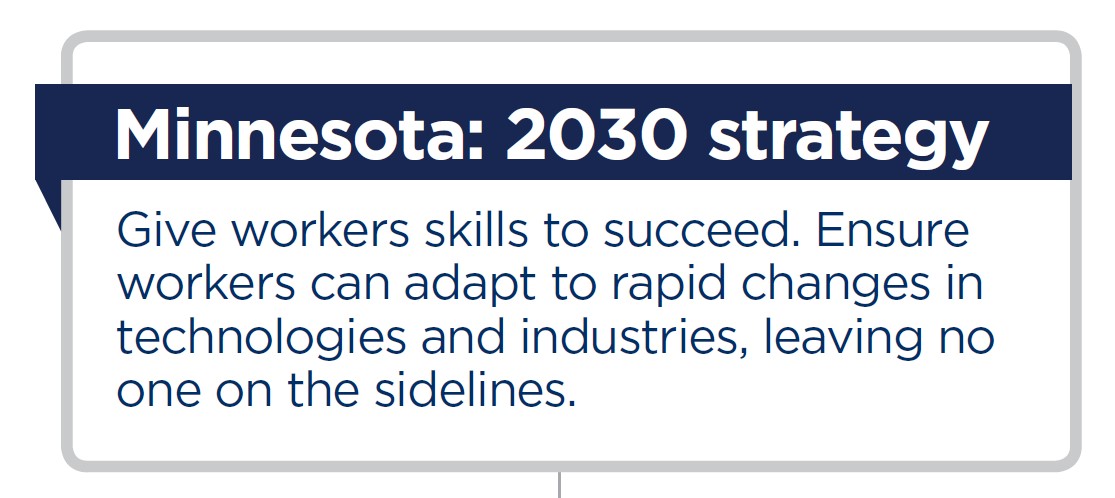
Strengthen community assets – Housing
One of Minnesota’s economic assets, believe it or not, is affordability, especially compared to the more expensive east and west coasts – and housing is a critical piece of that.
Unfortunately, Minnesota’s housing market is not producing enough affordable housing for entry-level homeowners. The 2018 Minnesota Governor’s Task Force on Housing report found Minnesota needs to enable private sector building of 300,000 new homes to stabilize prices and keep up with demand this decade.
New strategies are needed. State, regional and local policymakers should undertake a rigorous cost/benefit analysis to assess and streamline the many regulations impacting housing, including permitting, zoning, and construction codes to make building housing more affordable. Policymakers, non-profits, builders and communities are also coming together to spur new construction and preserve housing stock in certain communities. But more must be done.
The Housing Affordability Institute in 2019 finds:
- New homes in Minnesota cost more than any Midwest market. A comparable home in Hudson, Wisconsin, for example, costs $47,000 less than the same home in the east Twin Cities.
- The Twin Cities has one of the highest gaps between new and existing home prices in the nation.
- The disparity in homeownership rates between white and non-white Minnesotans is the highest in the nation.
- The Greater Minnesota Housing Fund continues to be a major driver of retaining and developing housing in Greater Minnesota, but the demand outpaces resources.
Strengthen community assets – Connectivity
Connectivity will only be more important in the coming decade. Minnesota could take the lead supporting innovation in this area.
High-speed digital access is developing quickly in ways that may prove more cost effective for underserved areas. As access grows, the “last mile” cost per connection may increase. Wireless and satellite connectivity should be explored to determine whether such methods can meet reliability needs. Incentives may be necessary to test deployment in different conditions. Rapid analysis of total cost, speeds, service reliability and subscription rates should follow within 12 months. If shown to be effective and competitive with traditional wired broadband at similar or lower costs, the state grant program should be modified to allow such solutions.
Progress on child care, housing and broadband must accelerate if Minnesota is to achieve its full economic potential this decade.
Embrace all Minnesotans: Make workforce inclusion a strength
Closing the achievement gap and fixing our racial disparities is not just a moral imperative – it is also an economic imperative.
Minnesota has among the worst racial disparities in the country, ranging from employment to housing, health care to education and criminal justice to poverty. The importance of embracing all Minnesotans’ ability to contribute is obvious.
This conversation often focuses on “closing the gap” between white citizens and communities of color on a range of social and economic indicators. While necessary – and an appropriate goal of change – this suggests our work would somehow be done if we can get two lines to converge on a graph.
That’s too small a goal. The better objective would be to embrace all Minnesotans and make workforce inclusion a strength. Because it would be wholly transformative.
If Minnesota embraced and valued the contributions of all – the economy would dramatically benefit. Making workforce inclusion a strength would grow Minnesota’s economy like no other.
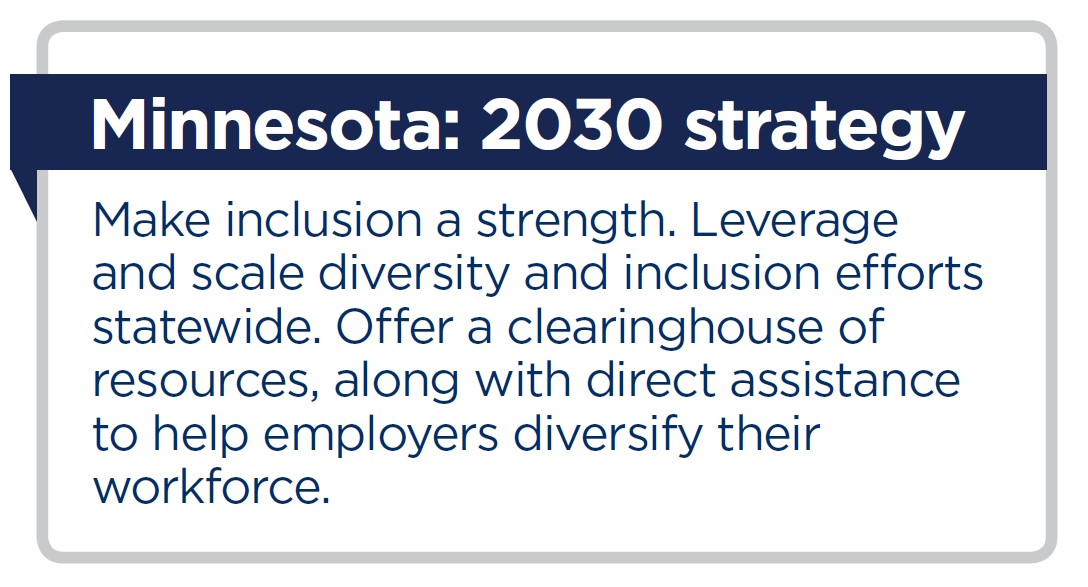
Are we close to that ideal? No. Far from it – as the data indicate.
But making Minnesota a state where people of all backgrounds can thrive, including people from diverse backgrounds around the world, could overcome many of our most significant challenges.
Increasing opportunities for communities of color will boost our economy. Businesses could better recruit and welcome diverse talent from across the U.S. and internationally, adding richly to the talent of the workforce. Immigration has been a Minnesota strength. That can be leveraged as a positive experience.
Embracing all would be a mindset change for some; social challenges are rooted in every segment of society. But Minnesota’s business sector is innovative and committed – a powerful asset in driving change.
Even setting such a goal requires a dynamic, growing economy able to provide people of all backgrounds with tools and opportunities to pursue meaningful careers or start new businesses. Economic opportunity is the cornerstone of dynamism – and likely only happens with the sustained commitment of Minnesota’s private and public sectors.
Promising efforts are underway, with companies investing significantly in new models. Initiatives at scores of organizations are accelerating change and investing in Minnesota’s diverse talent pool. We detail examples in our full report. The breadth and scope is encouraging, and we believe such initiatives should be embraced as laboratories of workforce inclusion and innovation. We will test, replicate and scale successful programs. We will promote our success in recruiting diverse talent from around the globe.
Rather than cover up Minnesota’s unacceptable disparities, we will address and correct them. But embracing workforce inclusion as economic justice is a growth strategy as well.
Meaningful change requires that we change as Minnesotans. But it’s a powerful idea. Because embracing all Minnesotans and making workforce inclusion a strength would be a powerful growth accelerator.

